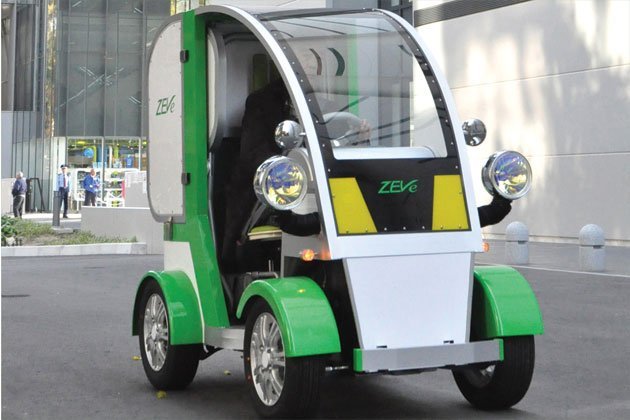Japan Tries Cars That Make the Mini Look Maxi

That’s drawn the attention of both established automakers and a new generation of startups eager to provide low-powered transportation for Japan’s aging population. “This is a once-in-a-lifetime chance,” says Yoshiro Sugimoto, 62, a Toyota Motor (TM) veteran who’s pooled 20 million yen ($254,800) of his and colleagues’ cash in a quest to build Japan’s smallest cars.
Town EV, Sugimoto’s startup, plans to have its 800,000-yen ($10,000) ZEVe ultracompact on the market in Japan next year. The aluminum-framed one-seater prototype is a narrow cart with a windshield, canopy, hatchback-style trunk, and no side windows or doors. It’s designed to travel as far as 50 kilometers (31 miles) when fully charged at a top speed of 50 km per hour. Sugimoto, whose Toyota career included years as an assistant to then-President Shoichiro Toyoda, says sales of the ZEVe should reach 1,000 by 2015, and prices may dip to as low as 600,000 yen per vehicle. To hold down costs, Town EV will build the car at fabrication shops run by subcontractors until sales reach a scale to warrant a full assembly line. It has no plans to introduce the cars in the U.S.
Japan’s government sees the new category as a way to ease travel for the elderly living in areas without convenient bus services. Many in Japan—which has the world’s highest proportion of seniors, with almost a quarter of the population over age 65—aren’t comfortable riding scooters. To promote sales, the government will offer subsidies to companies and local governments that purchase ultracompacts, according to Transport Ministry spokesman Akihiko Hoshi. The payment would be half an ultracompact’s price for as many as 3,000 vehicles over three years.
Toyota and rivals including Honda Motor (HMC), Suzuki Motor, Daihatsu Motor, and Nissan Motor (NSANY) have introduced prototype ultracompacts at auto shows but have not announced plans to sell the cars in Japan. “We are quite interested in the program, and research and development is under way,” Honda President Takanobu Ito told reporters in June. “I believe demand will be created when you have the products on the market.” Takeshi Matsunaga, who oversees electric car projects at Toyota Auto Body, a division of the automaker, predicts ultracompact demand will be “at least 70,000 units a year” after the government allows them on the road.
Still, the cars face obstacles, including concerns about safety. “Ultracompacts look easy to crush,” says Ikuo Doi, a 73-year-old in Ayabe city, near Kyoto, who drives a car. “And it is very inconvenient, as these cars can’t carry many farming implements or tools.” Still, some say that their diminutive size could be a plus: The government is expected to approve the vehicle category because their slow speeds and light weight mean they pose less of a danger to other vehicles or pedestrians, Sugimoto says.
Ultracompacts are already allowed on roads in many parts of the world. Europe has a class of low-power cars known as moped autos. In Germany, they are defined as light—less than 772 pounds—and have a top speed of 28 miles per hour. Britain’s Peel Engineering has started selling two three-wheeled models that are street-legal in the U.S., including the P50, a $16,000 one-seater that’s also available with an electric motor.
At Japan’s Gunma University, former Fuji Heavy Industries engineer Shuji Matsumura leads an ultracompact-development team comprising six veterans of his old employer’s Subaru cars business. For him, the point isn’t reducing size, but improving efficiency. Explains Matsumura: “There is a lot of waste in our current transportation system—for example, one man driving a four-seat car.”
The bottom line: Japan may soon approve the sale of ultracompact cars. Up to 70,000 of the tiny vehicles eventually could be sold there annually.
Nouvelles connexes


